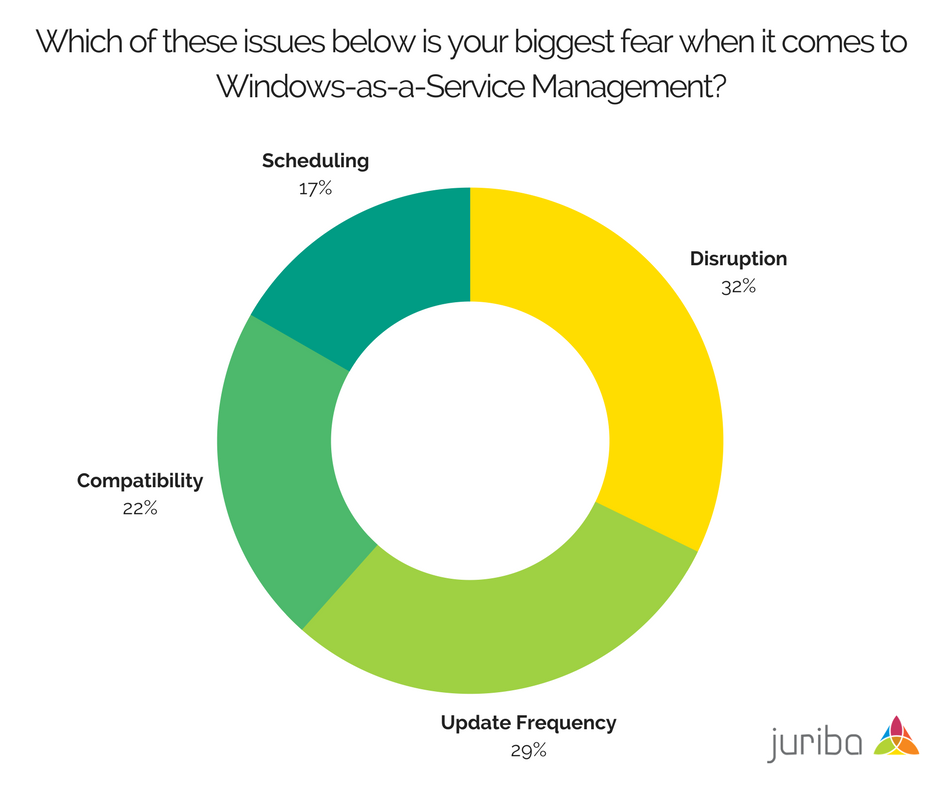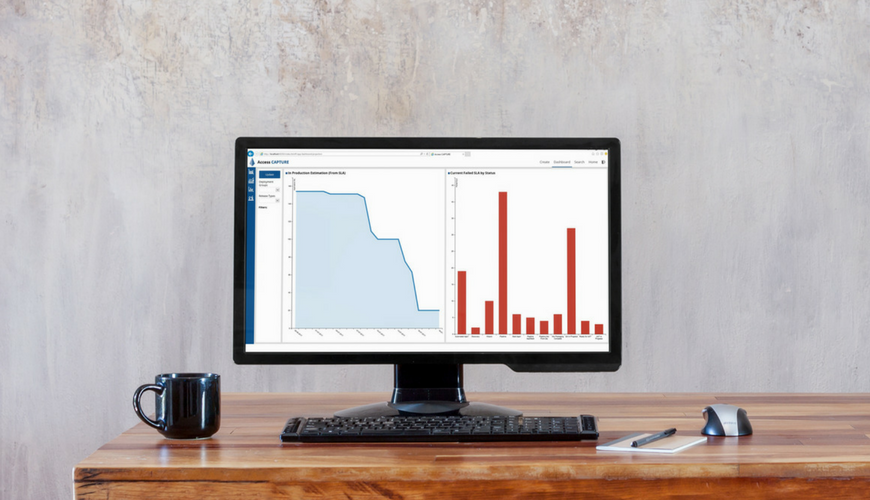 According to a quick poll of 419 IT project managers and IT executives done by Juriba, 32% of respondents said they are most afraid of the potential business disruption caused by Windows-as-a-Service roll outs, while 22% fear potential application compatibility issues most.
According to a quick poll of 419 IT project managers and IT executives done by Juriba, 32% of respondents said they are most afraid of the potential business disruption caused by Windows-as-a-Service roll outs, while 22% fear potential application compatibility issues most.
These fears, though often downplayed by Microsoft, are very realistic and viable! A Windows 10 migration will often touch more than 1,500 applications within an enterprise — that means potentially packaging and testing more than 3,000 apps a year!
Doing this manually, without a strategic Evergreen IT management approach and with no scalable and repeatable process, is completely inconceivable. But where do you start?
[For more IT automation ideas, check out our resource guide “12 Ways The Fast And Bold Use IT Automation To Achieve Evergreen”.]
Today, I want to walk you through a 7-step process that will help you streamline your application packaging and testing process in an Evergreen IT environment and point out a few things you should be aware of before starting
 .
.
Evergreen IT App Compatibility Considerations
One of the most efficient and cost effective ways to manage your applications during a Windows 10 rollout in an Evergreen IT fashion is to apply a Windows 10 MST on your existing MSI application estate to manage the various areas of change needed for standards and adjusting Windows 10 icons on the Start Menu. These robust changes made for Evergreen Windows 10 packaging packages can be used in the future if/when you decide on your app virtualization vendor strategy.
Another consideration is 64-bit. Many organizations decided to move from a 32-bit environment (e.g., Windows XP) to 64-bit (e.g., Windows 7) during previous migrations. This alleviates a huge part of the application compatibility challenge already as the prior application remediation process and repackaging exercise will have taken care of the new folder structure and registry hives introduced with a 64 bit operating system. If that is the case for you, the majority of your MSI application packages are likely to install and function OK.
However, do keep in mind that Windows 10 does introduce a new structure to the Start Menu and therefore many of your MSIs will need some kind of adjusting to position the application in the correct A – Z listing. Therefore, a touch, although light, is required even just to introduce and align with the new naming standards.
Finally, while the application compatibility rate from Windows 7 64bit to Windows 10 64bit is very high (in the region of 80%+), it is definitely worth running all your portfolio through an Application Certification process to ensure which applications require some minimal change and which will require further remediation with vendors or developers, or have to be re-developed or newly purchased due to technical supportability reasons or licensing.

7 Steps To A Streamlined Evergreen Application Packaging & Testing Process
For continuous testing and application management to work in an Evergreen IT environment, you will have to create a robust, repeatable and largely automated application management process that encompasses the following steps:
- CERTIFICATION. Always carry out certification testing of your product on the latest Windows 10 build. Because Microsoft releases two new feature updates (one in March and one in September) as part of its new Windows-as-a-Service support model, this will have to be done twice a year. To do the certification testing, provide each application owner with a virtual machine and track his test results.
- ANALYSIS. After all or the majority of your application estate has undergone the fast and easy certification process, you are now able to understand your application life cycle management and your scope of products. Instead of running all of your apps through a more invasive packaging and testing process, you can now determine, which applications really require further intervention. This can save you up to 75-80% of your packaging efforts!
- PACKAGING. Now that you know what is in scope, you can move into re-packaging of your applications into new versions of MSI /MST where needed or you can create virtual packages of your already signed off applications. Since most enterprises still will have to funnel dozens if not hundreds of packages through this process, you should ensure that you are using automation to streamline your discovery and documentation creation as well as smart workflows to speed up the process.
- TESTING. Once packaged, the applications need to be tested to ensure that they are robust enough for mainstream release. This is done by carrying out a non-functional test which focuses on performance, reliability, security, scalability, and so on. This step answers questions like: Does the application start and shut down without any issues? Does this app consume too much CPU or memory capacity?
- USER ACCEPTANCE TESTING. After the applications have passed non-functional testing, it is time to send them to their respective application owners for user acceptance testing (UAT). Manual UAT can be a lengthy and resource-hungry process as you have to set up and wipe clean machines for each user. Alternatively, you can use Access Capture’s smart workflows and automated packaging and testing capabilities. The platform will spin up a virtual machine with the latest Windows 10 build within seconds and notify them by an email that includes all necessary information, such as login details. The platform also automatically tracks the functional UAT test to ensure the application installs and functions on a new version of Windows 10. In addition, you can track and look back at previous application performance metrics captured from UAT sign-off data from previous Windows 10 build version testing.
- RELEASE. Only if a new version of the application is required, a new deployment of files will be necessary. This step is only required, on average, for about 20% of the apps.
- ENABLE. Once the newly re-packaged and tested application is released and signed off by users, it can be made available in your corporate app store, which will then make it visible and accessible to all users.
Depending on how tight your application management was up to this point, this process might be easier streamlined or require a major organizational effort to get in line with an Evergreen IT management process. If the latter is the case, do not lose heart. While this might seem overwhelming, the effort will be well worth it.
Now is the time to start managing your app estate using an automated packaging and testing platform that will take care of all of your Evergreen IT application management requirements in ONE place!
